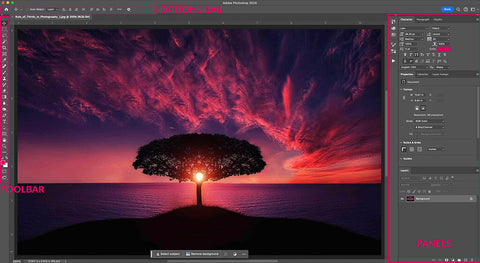- Lightroom Presets
- Mobile Presets
-
Photoshop
-
Learn
-
Support
-
Install
- Best Sellers
- Blog
By Ana Mireles on | No Comments

Conceptually, Photoshop layers resemble a stack of transparent sheets, much like a stack of papers. Each layer in this stack contains a specific element or object, and the beauty of this system lies in the fact that these layers function independently. This means you can edit or modify elements on one layer WITHOUT affecting the other layers or your original image.
In essence, working with layers in Photoshop is a non-destructive approach, allowing for flexibility and creativity WITHOUT PERMANENT CHANGES.
These layers come in different types, and each type serves specific purposes based on the content you're working with. Additionally, these layers can interact in various ways, which adds depth and complexity to your design.
Let's start by exploring the various types of layers you can utilize in Photoshop to bring your creative ideas to life:
The most common type of layer in Photoshop is the Raster Layer, which stores pixel-based data, typically images.
When you open an image, it initially appears as a locked layer known as the Background, which is a raster layer containing pixels.
Any edits you make to these layers are irreversible, meaning you can only undo them by accessing the History panel. Once you save and close your image, you won't be able to reverse those changes when you reopen it.

Any layer in Photoshop can be converted into a Smart Object, and you can even turn multiple layers into Smart Objects.
The primary characteristic of this layer type is that it allows for non-destructive editing.
Another noteworthy feature of Smart Objects is their ability to be linked across multiple projects. Consequently, when you change one of them, the linked instances in other projects will also be updated. This interconnectivity extends to working with various Adobe software, such as Adobe Illustrator and Adobe Premiere Pro.
Finally, when you apply a filter to a Smart Object, it automatically becomes a Smart Filter, which allows you to revisit and adjust the filter settings at any time.

True to their name, text layers contain textual content, offering the flexibility to revisit and modify the text, fonts, and other attributes at any time.
If you need to apply specific filters or image-oriented edits, you can rasterize a text layer. However, this transformation will make the text uneditable, as it becomes an image composed of pixels.
Alternatively, you can convert a text layer into a Smart Object. This allows you to make image-related edits within the current document. To revise the text, simply double-click on the Smart Object, which opens in a separate tab.

Shape Layers are different from Raster Layers in that they store vector information instead of pixels. Every time you create a shape, a corresponding Shape Layer is generated.
You can modify the properties of these shapes using the Properties panel and the Options bar at any time. This includes adjustments like altering the fill, changing the color, and adjusting stroke width, among other properties.
Like Text Layers, you can choose to rasterize Shape Layers, enabling you to utilize image editing tools. Nevertheless, this conversion also results in the loss of the shape's inherent vector properties. Also, like Text Layers, the alternative approach is to convert them into Smart Objects, combining the advantages of both vector and raster elements.

There are 19 distinct types of Adjustment layers, categorized into two groups: Fill layers and Editing layers. These layers allow you to manipulate your images in a non-destructive way.
Fill Layers
Editing Layers
It's worth noting that all the editing tools listed here can also be found in the menu Image>Adjustments. However, when you use the commands from the menu, you are modifying the original image, which means those changes will be irreversible.
Instead, when you employ an Adjustment layer for these edits, you maintain the ability to continually modify, erase, adjust opacity, etc., which provides you with more control and flexibility.

To work with layers, you have two primary options: you can utilize the Layers panel or navigate through the Layer menu. Let's see how each of these methods function:
The Layer menu works like any other menu in Photoshop. It takes the form of a dropdown menu, where you'll find an array of available options and actions.
For those actions with a submenu, an arrow icon serves as an indicator, signifying the option to open it for additional choices. If a particular action has a keyboard shortcut, you will typically find the shortcut listed beside its name in the menu.
It's important to note that most actions featured in the Layer menu are also accessible directly through the Layers panel.

For quicker access and a more streamlined workflow, most features and actions related to layer management can be found in the Layers panel.
By default, all preset workspaces have the Layers panel activated, and it's advisable to keep this setup because of its usefulness.
Nevertheless, you can enable or disable it through the Window menu or by using the F7 key shortcut.
Located at the top of the Layers panel is the search bar, equipped with a drop-down menu that allows you to specify the type of filter you wish to apply (typically set to "Kind" by default). The icons on the right of the menu will change dynamically based on the filtering you choose.
Directly beneath, you'll see the Blending Mode and Opacity settings, which allow you to adjust how the currently selected layer interacts with the layers positioned below it.
Proceeding further down, you'll find the Lock options, which can be used to protect all or a part of a layer from accidental modifications. Next to this is the Fill slider, which controls the layer's opacity without affecting any Layer Styles if present.
The main body of the panel displays the actual layers. On the left, you'll see the visibility icon. Following this is a thumbnail or an icon that indicates the layer type. Next, the layer's name is displayed, which can be changed by double-clicking on it.
At the bottom of the panel, you'll discover a menu offering various actions. From left to right, they are:

As I previously mentioned, Photoshop layers provide a non-destructive approach to editing, but their benefits extend beyond this fundamental advantage.
Thanks to their range of properties, Photoshop layers offer a heightened level of control for your edits. Let's explore how you can effectively use and manipulate layers.

By default, all layers have 100% opacity, meaning that they completely conceal the layer that’s underneath.
When you reduce the opacity of a layer, you make it more transparent. As a result, the layers below them will become more visible.
When working with Adjustment layers, lowering the opacity means that the adjustments will be less visible and have a weaker effect on the image. Conversely, increasing the opacity will make the adjustments more visible and have a stronger effect on the image.
Next to each layer, you’ll find an eye icon. A simple click on this icon lets you switch the layer's visibility on or off.
This feature proves invaluable when you want to compare the before and after versions of your work.
When dealing with multiple layers, you can arrange them into groups. This organization serves the dual purpose of enhancing management and facilitating the application of masks or adjustments to a specific group.
The sequence of your layers holds significance. You can rearrange them as needed by simply clicking on a layer and dragging it to a different location.
For the sake of organization, you can also assign distinct color labels to each layer. To accomplish this, right-click on the layer and choose the color you want.
When you work with layers, you have the ability to control the way they interact with each other by changing the blending mode.
These blending modes are categorized into groups based on the specific manner in which they influence layer interactions.
Blending Modes in Photoshop provides a powerful way to control how layers interact with one another. These modes can lighten, darken, or enhance contrast in the image, allowing you to achieve various visual effects.

In Photoshop CC, you have the convenience of previewing the effect simply by hovering over a blending mode. However, in Photoshop CS6, you must apply the blend mode to see its impact on the image.
Here are the different blending mode categories and the blending modes within each:
Normal: These blending modes maintain the original colors and tonal values of the layers without any specific interaction.
Darken: These modes tend to darken the image, emphasizing the darker areas.
Lighten: These modes lighten the image and accentuate the brighter areas.
Contrast: These modes increase contrast in the image, emphasizing both dark and light areas.
Invert: These modes produce inverse color and contrast effects.
Component: These modes modify individual color and tonal components.
Layer Masks offer a powerful method for concealing specific portions of a layer without permanent deletion. This flexibility enables you to make adjustments, feather selections, and more without irreversible alterations.
In a layer mask, any area painted black becomes invisible, while regions in white remain visible. The use of various shades of gray allows you to control the opacity of selected portions of the layer. Additionally, employing gradients within a layer mask is also an option.

Understanding and effectively utilizing Photoshop layers is an essential skill for any aspiring digital artist or photo editor. Layers serve as the building blocks of your creative process, offering a non-destructive means to manipulate, adjust, and enhance your images. By thinking of them as transparent sheets stacked on top of one another, each with unique content, you gain unparalleled control and flexibility over your work.
Whether you're retouching a portrait, creating digital art, or designing eye-catching graphics, understanding layers is your key to achieving professional results.
Do you have any questions or comments about Photoshop Layers and How to Use Them? Leave us a comment below - we would LOVE to hear from you! And PLEASE SHARE our tutorial using the social sharing buttons (we really appreciate it)!




Ana Mireles is a Mexican photographer and researcher with a passion for writing and teaching. She’s collaborated in artistic and cultural projects in Mexico, Italy, and the Netherlands.

Comments